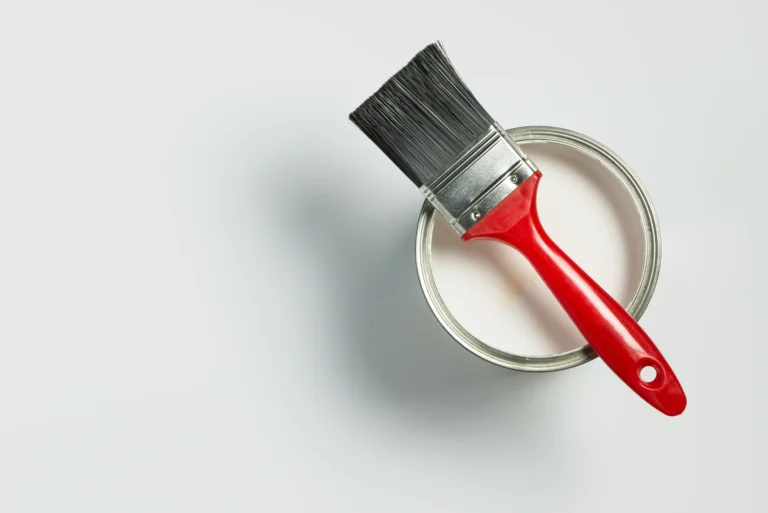Painting wood adds beauty, color, and protection to one of nature’s most versatile materials. However, the type of paint you use can determine whether the finish lasts years or starts peeling within months. Knowing what paint to use on wood helps you avoid costly mistakes and ensures that your surfaces stay durable and attractive. The right paint depends on the location, purpose, and condition of the wood. With proper preparation, primer, and product choice, you can achieve a finish that stands up to daily use and the elements.
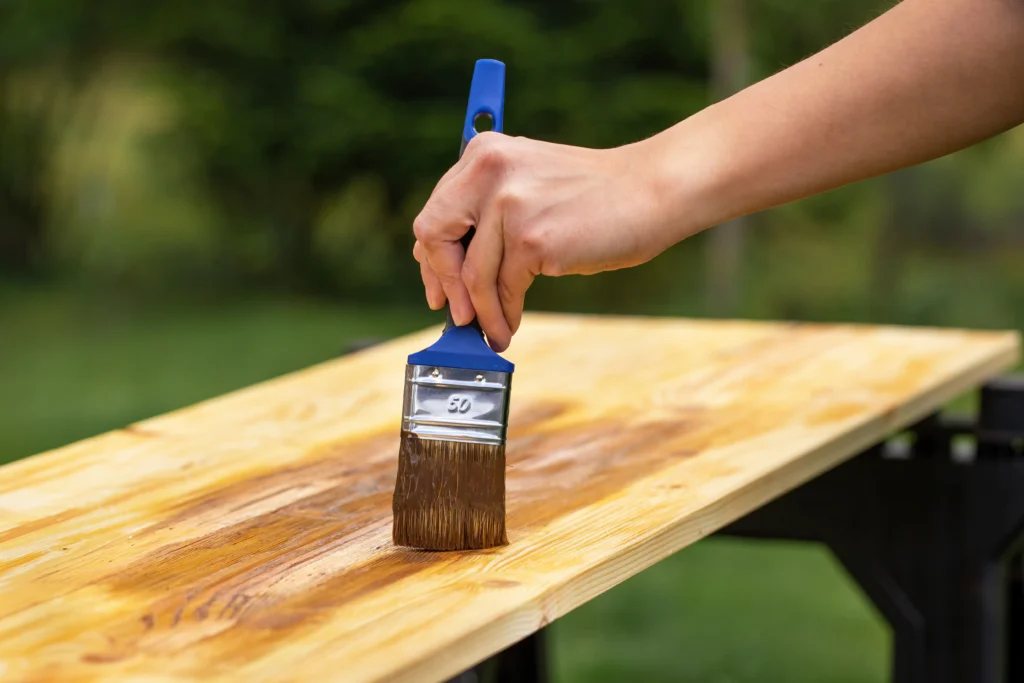
Why choosing the right paint matters
Wood expands and contracts with humidity and temperature changes. If the paint doesn’t move with it, cracking and peeling can occur. The right paint forms a flexible bond that allows for movement while sealing out moisture. It also resists fading, scratching, and dirt buildup. Professionals at Four Seasons Painting Co. evaluate each project before choosing the right coatings so that every surface, from baseboards to deck,s receives the best protection possible.
Main types of paint for wood
There are several reliable paint types suitable for wood, each offering specific advantages depending on the project. The main options include latex, oil-based, acrylic, and chalk paints. Understanding how each one performs helps you decide which is best for your application.
Latex paint
Latex, or water-based paint, is one of the most common choices for indoor wood surfaces. It dries quickly, cleans up easily, and emits minimal odor. Latex paint also expands and contracts with wood, reducing the risk of cracking. Because it retains color well and resists yellowing, it’s ideal for trim, furniture, and wall paneling. High-quality latex enamel provides a smooth, washable finish that’s easy to maintain in living spaces. Modern formulas are much more durable than earlier versions, making latex a go-to for both homeowners and professionals.
Oil-based paint
Oil-based paint delivers a hard, durable finish perfect for high-contact areas like handrails, window frames, and doors. It adheres strongly and levels beautifully, leaving minimal brush marks. Its slow drying time allows for a professional-looking finish but requires patience and proper ventilation. Oil-based paints resist heavy wear and provide a traditional glossy look that many people still prefer. Cleanup requires mineral spirits, but for longevity and sheen, this paint remains unmatched on certain projects.
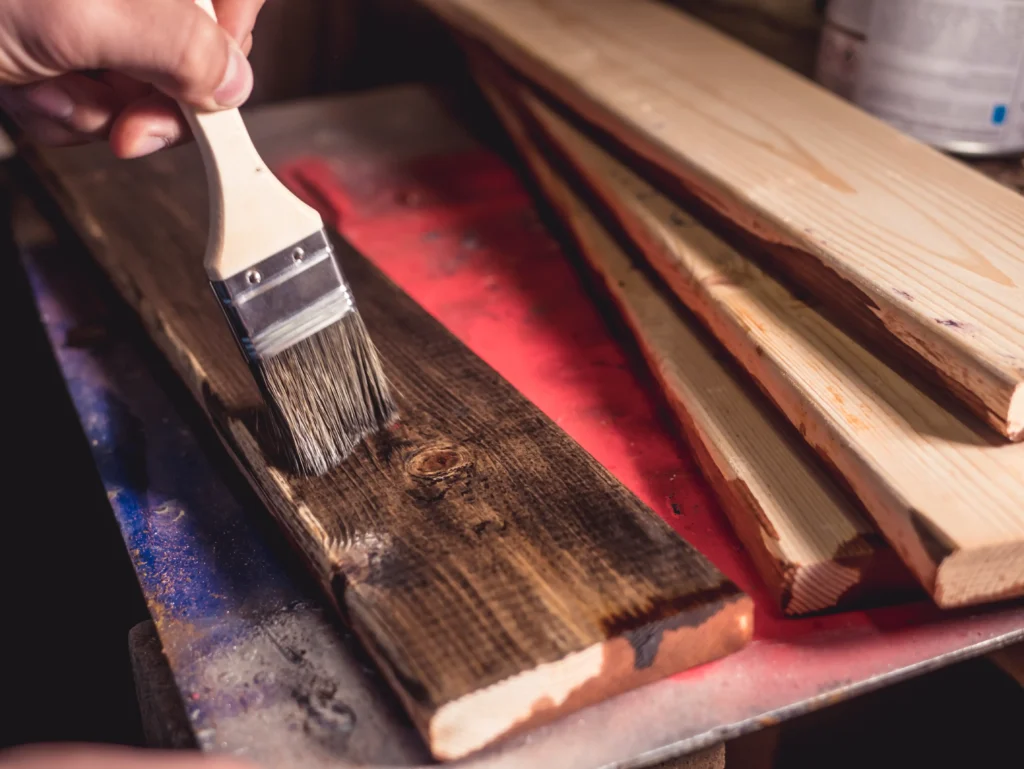
Acrylic paint
Acrylic paint, a cousin of latex, provides excellent adhesion and flexibility. It is resistant to fading, moisture, and cracking, making it suitable for both interior and exterior use. Acrylic latex paints are often recommended for outdoor wood surfaces because they handle UV exposure and rain better than traditional oil paints. The quick-drying nature and low odor of acrylics make them convenient for indoor furniture or trim work as well. For guidance on top-performing acrylic paints, you can explore Sherwin-Williams Duration Home Acrylic Latex, which is designed for long-lasting adhesion and easy maintenance.
Chalk paint
Chalk paint is popular for furniture and décor because of its matte, vintage finish. It adheres well even with minimal surface preparation, making it a great choice for quick updates. However, chalk paint is not as durable as other types and usually requires a wax or polyurethane topcoat to seal and protect the finish. It works best for low-traffic items like shelves, decorative pieces, or accent furniture rather than cabinetry or doors.
Choosing the right finish for wood
Once you know what paint to use on wood, the next step is choosing the right finish or sheen. The finish affects both the appearance and durability of the surface. Flat and matte finishes give a soft, non-reflective look but can be more difficult to clean. Satin and semi-gloss finishes are more durable, easy to maintain, and work well for trim, doors, or furniture. Glossy finishes add maximum shine and protection, making them perfect for high-contact areas. For most wood projects, a satin or semi-gloss enamel is the best option, offering a balance of beauty and resilience. You can see examples of professional results on the Cabinet Painting Services page, where wood surfaces are refinished with premium products and expert techniques for long-lasting performance.
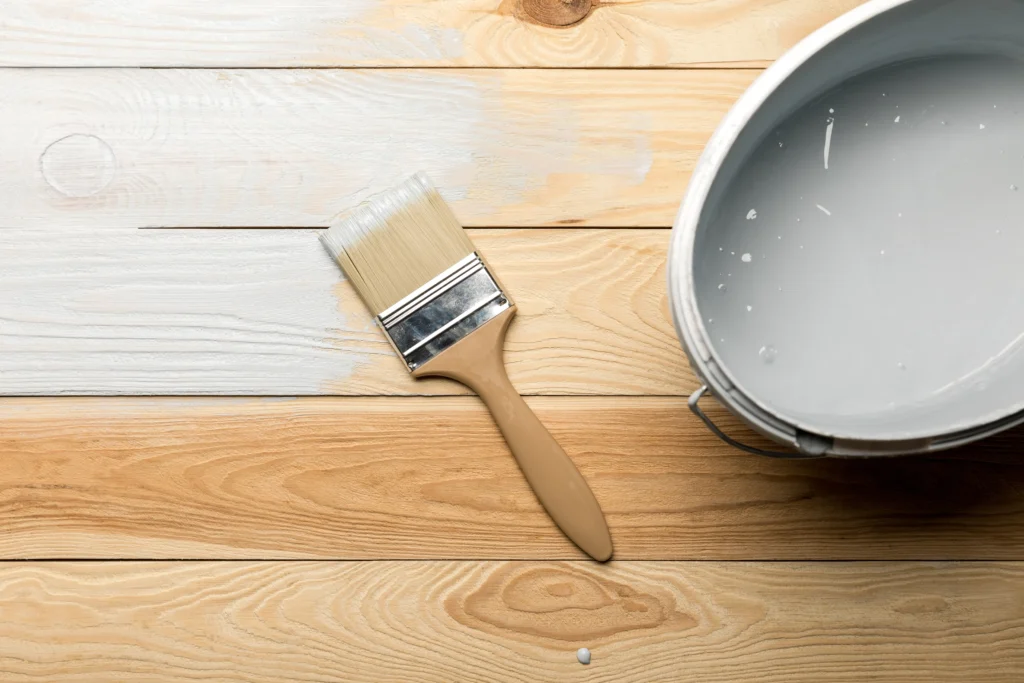
The importance of primer on wood
Before deciding what paint to use on wood, it’s just as important to start with the right primer. Primer seals pores, blocks stains, and ensures better paint adhesion. Without it, wood can absorb paint unevenly, leading to blotches, poor coverage, and early peeling. For bare wood, a stain-blocking or bonding primer is ideal, while a universal primer works well when repainting over old paint or varnish. Using a tinted primer can also make it easier to cover dark wood with lighter colors, reducing the number of coats needed for a smooth, even finish.
Preparing wood before painting
Surface preparation is the foundation of a quality finish. Start by cleaning the wood to remove dirt, oils, or old finishes. Sanding smooths imperfections and opens the pores, allowing primer and paint to adhere properly. For exterior projects, power washing followed by thorough drying ensures a clean surface. Old, peeling paint should be scraped away completely before repainting. Once sanded, wipe the wood with a damp cloth or tack cloth to remove any leftover dust. For homeowners tackling large outdoor wood surfaces like decks, fences, or siding, cleaning is critical. You can learn how professionals handle this step on the Pressure Washing page, where surface cleaning is shown to extend the life of every coating.
Interior vs. exterior paint for wood
When deciding what paint to use on wood, it’s important to understand that interior and exterior paints serve different purposes. Interior paints are made for color retention, smoothness, and easy cleaning in temperature-controlled environments. Exterior paints, on the other hand, contain additives that resist mold, UV rays, and moisture. Using exterior-grade acrylic or latex paint on outdoor wood helps prevent fading and cracking. Applying the wrong type of paint can result in peeling or reduced durability, so always choose products specifically formulated for the environment in which they’ll be used.
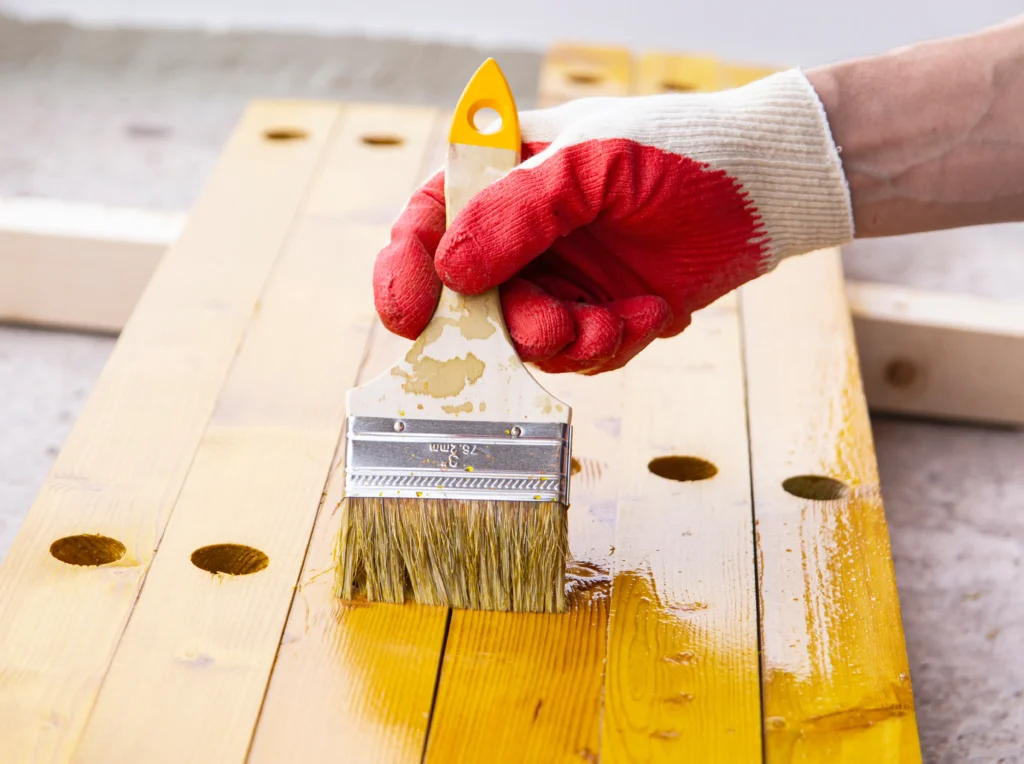
Specialty paints for unique wood applications
Some wood projects require specialized coatings for added protection. Marine paints work well on outdoor furniture, docks, or boats because they resist water damage. Heat-resistant paints are suited for surfaces near stoves or fireplaces. Enamel paints are excellent for cabinetry and trim, offering a durable, washable surface that resists chips. For creative or antique-inspired finishes, milk paint offers a natural matte texture and can be sealed with wax or clear coats for protection. To explore additional coating types and professional recommendations for various wood applications, the Benjamin Moore Advance Interior Paint guide offers insight into long-lasting, smooth finishes ideal for fine woodwork.
Low-VOC and eco-friendly options
When thinking about what paint to use on wood, modern paint technology offers plenty of eco-friendly options that don’t compromise on performance. Low-VOC (volatile organic compound) paints reduce chemical emissions, making them safer for indoor use. They also minimize odor and dry quickly, improving air quality during and after application. Many leading paint brands now produce eco-conscious formulas that perform just as well as traditional options, providing a sustainable way to protect your wood surfaces while being mindful of the environment.
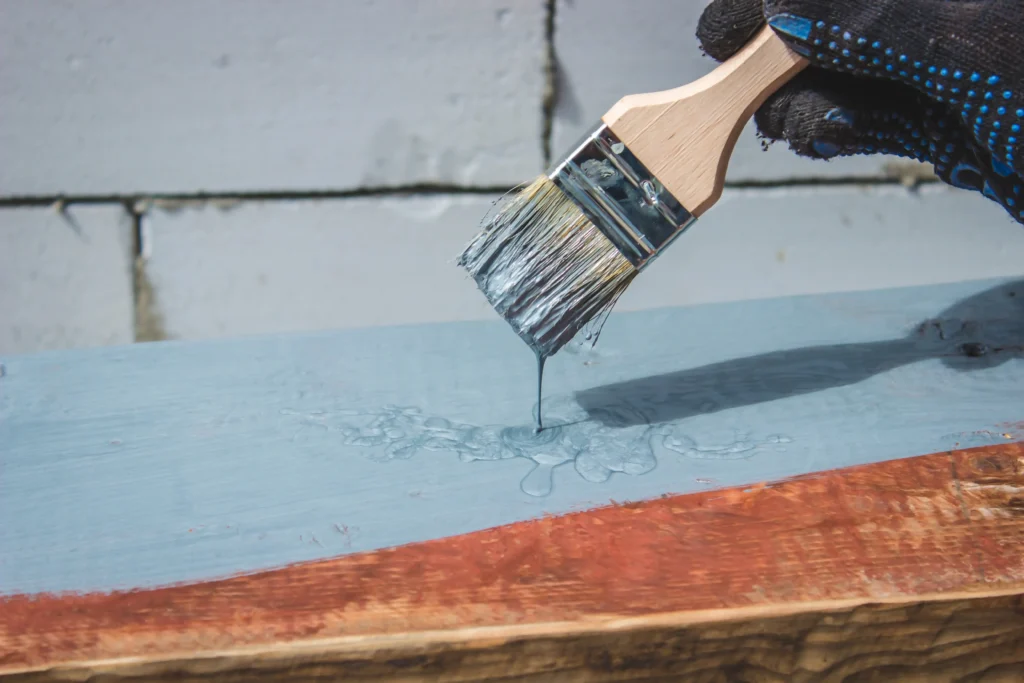
Applying paint correctly
Once the surface is clean and primed, apply the paint evenly along the wood grain. For most projects, two coats are ideal. Allow each coat to dry fully before applying the next to prevent bubbling or streaks. Lightly sanding between coats helps the next layer bond smoothly. For furniture or cabinetry, spraying produces the most uniform finish, while brushing works best for smaller, detailed areas. Finishing with a clear sealant can add shine and extra protection against moisture and scratches.
Common painting mistakes to avoid
Skipping primer, using interior paint outdoors, or failing to sand are the most common mistakes when painting wood. Rushing between coats or applying thick layers can also lead to drips and uneven texture. Taking the time to prep, prime, and apply multiple thin coats results in a professional-grade finish that lasts. Always check manufacturer instructions for drying times and conditions to achieve the best outcome.
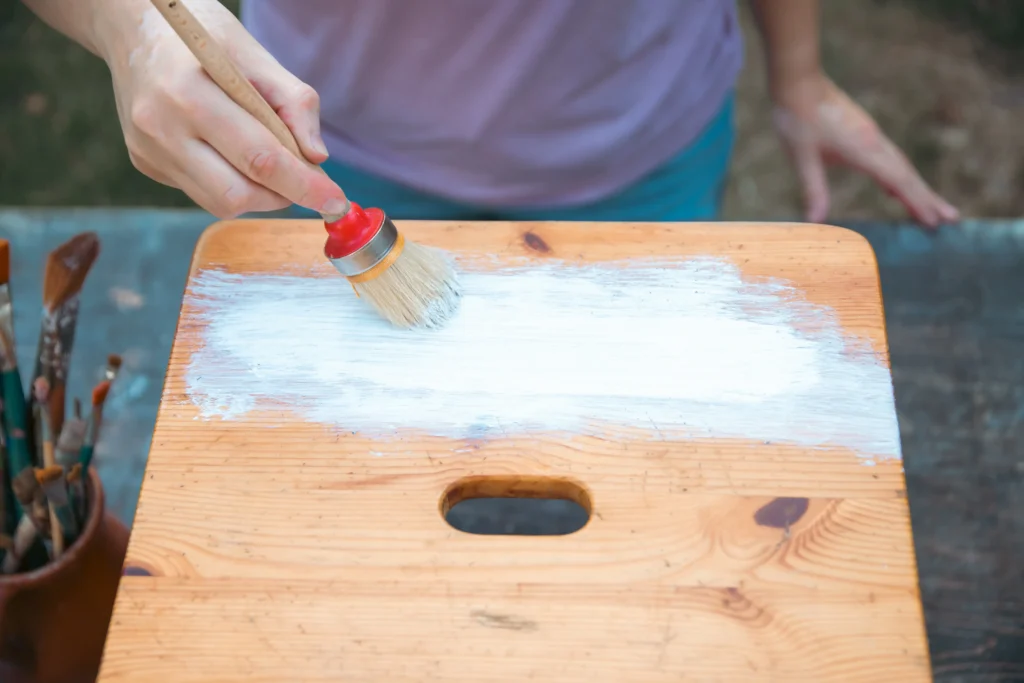
Conclusion
Knowing what paint to use on wood ensures your project looks beautiful and lasts for years. Latex and acrylic paints are perfect for interiors, while oil-based options shine in high-wear or outdoor settings. Always pair your paint with the right primer, prepare the surface properly, and apply multiple coats for lasting results. For expert wood painting and refinishing, contact Four Seasons Painting Co.. Their professionals use top-tier materials and precise techniques to achieve flawless finishes that protect and enhance your wood surfaces season after season.

